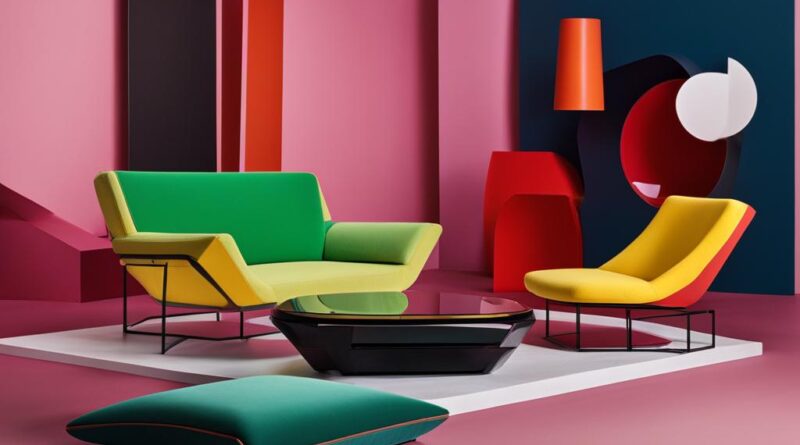Postmodern Furniture Guide: Trends & Styles
The world of interior design is constantly evolving, with new trends and styles emerging to meet the changing tastes and preferences of homeowners. One style that has gained popularity in recent years is postmodern furniture. Combining elements of contemporary and modern design, postmodern furniture offers a unique and avant-garde approach to home decor.
Postmodern furniture is characterized by its sleek and minimalist designs, unconventional shapes, and the use of unexpected materials. It draws inspiration from various design movements, such as classic modernism and avant-garde decor, to create a truly distinctive aesthetic. Whether you’re a fan of clean lines and geometric shapes or prefer more eclectic and vibrant pieces, postmodern furniture offers something for everyone.
Key Takeaways:
- Postmodern furniture combines elements of contemporary and modern design.
- It features sleek and minimalist designs with unconventional shapes.
- Postmodern furniture draws inspiration from various design movements.
- It offers a unique and avant-garde approach to home decor.
- Whether you prefer clean lines or eclectic pieces, postmodern furniture has something for everyone.
The Features of Postmodern Furniture
Postmodern furniture is known for its eclectic mix of design styles and the incorporation of diverse influences, including historical elements, craft revival, ergonomic furniture, and art furnishings. This distinctive style embraces a range of design movements, including classic modernism, Memphis style, Deconstructivism, and industrialized high-tech style.
The postmodern approach favors form over function, seeking to create surprising and awe-inspiring designs that challenge traditional norms. It celebrates the beauty of complexity and contradiction, offering a unique and bold aesthetic. Postmodern furniture allows for creative expression and the freedom to experiment with unconventional elements, resulting in visually striking and memorable pieces.
Postmodern furniture is not limited by the conventions of a single design movement. It blends different styles, materials, and influences to create an eclectic and dynamic mix that reflects the individuality and creativity of its designers and owners.
Notable designers in the postmodern movement include Robert Venturi, Michael Graves, Philip Johnson, Alessandro Mendini, Robert A.M. Stern, and Judy McKie. These talented individuals have made significant contributions to postmodern design through their innovative and unconventional creations.
To better understand the features of postmodern furniture, take a look at this table:
| Features | Description |
|---|---|
| Eclectic Mix | A blend of various design styles, materials, and influences |
| Historical Elements | Incorporation of historical references and motifs |
| Craft Revival | Emphasis on the skillful craftsmanship and revival of traditional techniques |
| Ergonomic Furniture | Furniture designed to prioritize comfort and user experience |
| Art Furnishings | Inclusion of artistic and sculptural elements in furniture design |
Postmodern furniture offers a bold and unconventional approach to design, allowing individuals to create spaces that are both visually striking and reflective of their unique style and personality.
Modern Décor Elements in Postmodern Style
postmodern furniture, pop art motifs, colorful glass vases, modern décor elements
To add interest to a postmodern style home, incorporating modern décor elements is essential. Here are some popular choices that can enhance the exuberance of the decor and contribute to the overall vibrancy of the space:
Pop Art Motifs
- Postmodern style often embraces the bold and playful aesthetics of pop art. Incorporating pop art motifs such as vibrant colors, comic book-inspired graphics, and iconic pop culture references can instantly add a sense of fun and nostalgia to your space.
Colorful Glass Vases
- Colorful glass vases are another popular choice in postmodern decor. These free-formed vases come in a variety of shapes and sizes, and their vibrant hues can inject a burst of energy into any room. Whether displayed as standalone statement pieces or used to showcase fresh flowers, these vases bring a touch of whimsy to your space.
Whimsical Themes
- Postmodern style allows for creative freedom and embraces whimsical themes. Incorporating unique pieces, such as furniture or decor items with unexpected shapes or unusual design elements, can add a sense of playfulness and intrigue to your space. Think outside the box and let your imagination run wild to create a truly one-of-a-kind postmodern environment.
By incorporating these modern décor elements into your postmodern style home, you can elevate its visual appeal and showcase your unique personality. Let your creativity shine and create a space that is as vibrant and unconventional as you are!
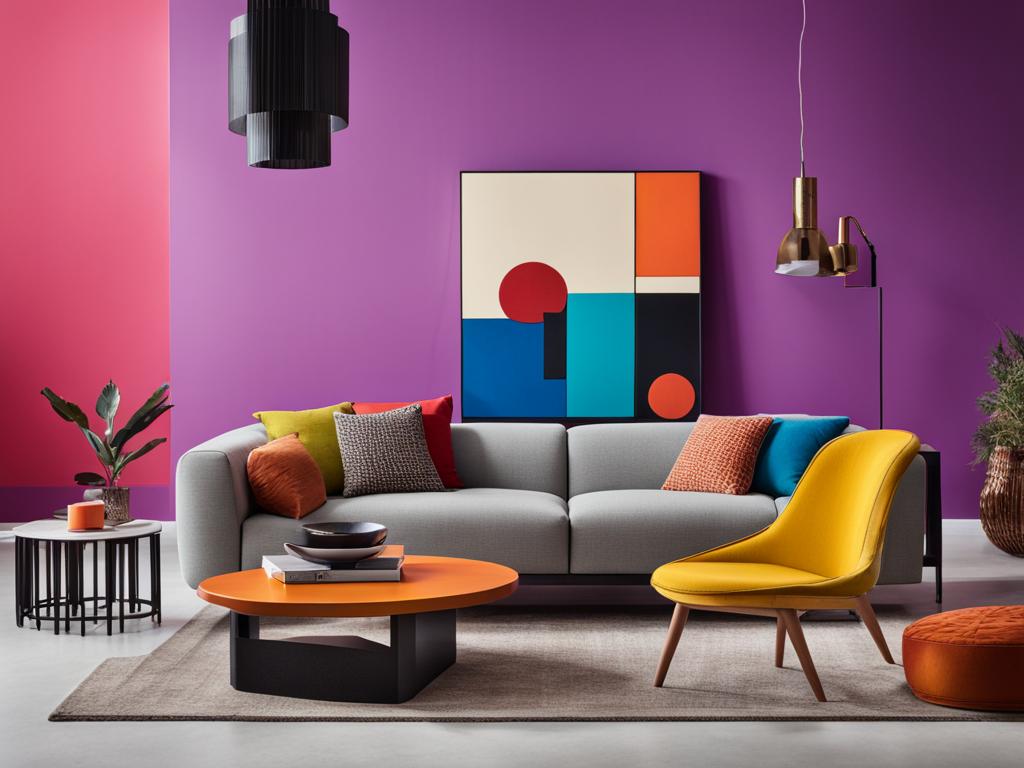
Materials Used in Postmodern Design
Postmodern design is known for its innovative use of modern materials to create unique and visually striking furniture and decor. This section explores the materials commonly used in postmodern design, including plastic, laminates, concrete, marble, glass, metal, wood, and recycled materials.
Plastic
Plastic is a versatile material widely used in postmodern design due to its malleability and ability to take on various shapes. It allows designers to create bold, unconventional forms and experiment with vibrant colors. Postmodern furniture often features plastic elements such as chairs with exaggerated contours or sleek transparent surfaces.
Laminates
Laminates are another popular choice in postmodern design. They provide a cost-effective way to achieve different textures and finishes while offering durability. Laminates can mimic the look of other materials, such as wood or marble, allowing for creative freedom in design without the cost associated with natural materials.
Concrete
Concrete is often used in postmodern design to create a rugged and industrial aesthetic. Furniture and decor pieces made from concrete can have smooth or textured surfaces, adding a unique tactile element to the overall design. Concrete is a versatile material that can be molded into various shapes, making it suitable for creating both functional and artistic pieces.
Marble
Marble is a luxurious material that adds elegance and sophistication to postmodern design. It is commonly used for tabletops, countertops, and decorative accents. The natural veining and patterns in marble create a visually appealing and unique aesthetic, enhancing the overall beauty of postmodern furniture.
Glass
Glass is a key material in postmodern design, providing transparency, lightness, and a sense of space. It is often used for tabletops, shelves, and decorative elements, adding a touch of sophistication and allowing for the display of other design elements. Glass can be clear, frosted, or tinted, offering versatility in postmodern furniture design.
Metal
Metal is a favorite material in postmodern design due to its durability, sleekness, and ability to add a touch of industrial or futuristic aesthetic. Steel, aluminum, and chrome are common choices for furniture frames, legs, and accents. Metal can be polished, brushed, or powder-coated, providing a range of finishes to suit different design preferences.
Wood
Despite the popularity of modern materials, wood remains a preferred choice in postmodern design. It brings warmth, natural beauty, and a sense of craftsmanship to furniture and decor. Wood can be utilized in its natural form or stained in various colors to complement the overall design. Different wood species, such as oak, walnut, and teak, offer distinct textures and grains, adding depth and character to postmodern pieces.
Recycled Materials
In the 1970s, the postmodern style embraced the trend of recycling and incorporated unexpected recycled materials into furniture and decor. This sustainable approach not only reduces waste but also allows for the creation of unique and eco-friendly pieces. Recycled materials can include reclaimed wood, repurposed metals, or even upcycled plastic, adding an element of creativity and environmental consciousness to postmodern design.
| Material | Benefits | Common Applications |
|---|---|---|
| Plastic | Versatile, malleable, vibrant | Chairs, tables, accessories |
| Laminates | Cost-effective, variety of textures | Countertops, surfaces, finishes |
| Concrete | Rugged, industrial, artistic | Furniture, decor, architectural elements |
| Marble | Luxurious, elegant, natural patterns | Tabletops, accents, decorative pieces |
| Glass | Transparent, light, spacious | Tabletops, shelves, decorative elements |
| Metal | Durable, sleek, industrial | Frames, legs, accents |
| Wood | Warm, natural, craftsmanship | Furniture, accents |
| Recycled Materials | Sustainable, unique, eco-friendly | Reclaimed wood, repurposed metals, upcycled plastic |
By incorporating these modern materials into postmodern design, furniture and decor pieces can achieve a bold and distinctive aesthetic, reflecting the unique style and personality of the homeowner.
“The creative possibilities of postmodern design come to life through the innovative use of materials, allowing for unconventional and visually striking furniture and decor.”
Notable Postmodern Designers
Several notable designers have made significant contributions to postmodern design. Their innovative and unconventional approaches have shaped the postmodern furniture movement, pushing the boundaries of traditional design norms. Let’s take a closer look at some of these influential designers:
Robert Venturi
Robert Venturi is widely regarded as one of the most influential architects of the postmodern era. He is known for his opposition to modern design principles, advocating for a more diverse and expressive approach. Venturi’s work emphasized the importance of historical elements, combining them with contemporary elements to create a unique and visually captivating aesthetic.
Michael Graves
Michael Graves was an American architect and designer who played a crucial role in bringing postmodern design to the mainstream. His iconic designs blended classical forms with whimsical and playful elements, showcasing a distinct sense of humor and personality. Graves’ creations, ranging from furniture to household products, continue to inspire and captivate designers and enthusiasts alike.
Philip Johnson
Philip Johnson was a prominent figure in both the modernist and postmodern movements. While he made significant contributions to the modernist movement, he also played a crucial role in the development of postmodern design. Johnson’s work often featured the incorporation of historical references and traditional architectural elements, challenging the notion of pure modernism and embracing a more eclectic approach.
Alessandro Mendini
Alessandro Mendini was an Italian designer and architect celebrated for his bold and vibrant designs. His work embraced postmodern principles, featuring striking colors, playful forms, and unique combinations of materials. Mendini’s imaginative and unconventional approach to design left a lasting impact on the postmodern movement, inspiring designers around the world.
Robert A.M. Stern
Robert A.M. Stern is an American architect and architectural historian known for his extensive body of work, which includes both modernist and postmodern designs. Stern’s postmodern creations often draw inspiration from historical architectural styles, combining them with contemporary elements to create visually striking and contextually sensitive designs.
Judy McKie
Judy McKie is a renowned furniture artist and sculptor known for her unconventional and whimsical designs. Her sculptural furniture pieces often incorporate animal forms and unconventional materials, pushing the boundaries of traditional furniture design. McKie’s work stands as a testament to the creativity and artistic expression that defines postmodern furniture.
These notable postmodern designers have left an indelible mark on the world of design, influencing contemporary furniture styles and challenging traditional design aesthetics. Their creative and unconventional approaches continue to inspire designers and enthusiasts to think outside the box and embrace the freedom of postmodern design.
Postmodern Style in the Bedroom
The postmodern style offers a unique and eclectic mix of design elements that can transform your bedroom into a one-of-a-kind sanctuary. By incorporating postmodern furniture and embracing a diverse range of styles, you can create a space that reflects your personal taste and provides a dynamic and intriguing atmosphere for rest and relaxation.
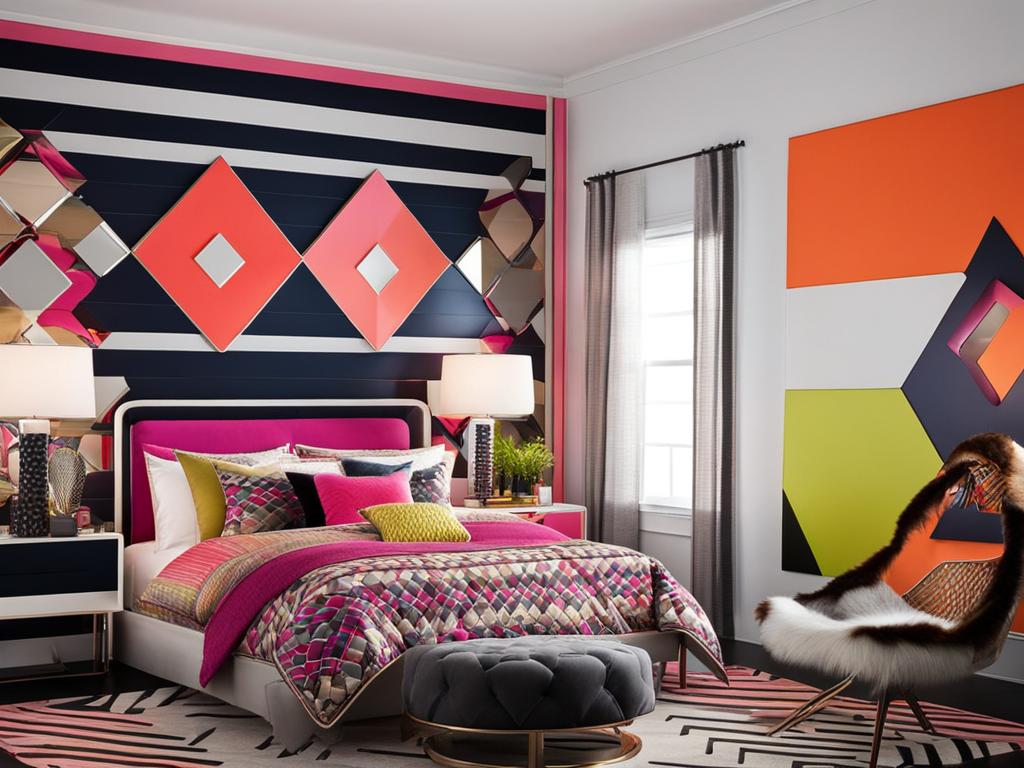
When designing a postmodern bedroom, the key is to embrace an eclectic mix of styles and create a unique blend of traditional and contemporary elements. This can be achieved by selecting postmodern furniture pieces that feature unexpected shapes, bright colors, and bold patterns.
Creating an Eclectic Mix
An essential aspect of postmodern style in the bedroom is the incorporation of an eclectic mix of design elements. To achieve this, consider combining furniture pieces from different eras and styles, such as pairing a sleek postmodern bed frame with a vintage-inspired dresser. This juxtaposition of different design aesthetics adds visual interest and creates a truly unique space.
Embrace the freedom to mix and match styles and experiment with unique combinations. A postmodern bedroom is all about breaking free from traditional design norms and creating a space that reflects your individuality and creativity.
Playful Colors and Patterns
Postmodern style encourages the use of vibrant colors and bold patterns in the bedroom. Consider incorporating colorful accent pieces, such as pillows or rugs, with geometric or abstract patterns to add visual excitement to the space. These playful elements contribute to the overall dynamic and energetic atmosphere of the room.
Balance and Harmony
While the postmodern style embraces an eclectic mix of styles and design elements, it is important to maintain a sense of balance and harmony in the bedroom. Ensure that the furniture pieces and decor items complement each other and create a cohesive look. This can be achieved through careful coordination of colors, materials, and shapes.
Creating a Unique Sanctuary
The postmodern bedroom serves as a unique sanctuary, combining elements of comfort, creativity, and self-expression. It offers a space for you to unwind and recharge, surrounded by furniture and decor that reflect your individual style and personality.
| Design Features | Benefits |
|---|---|
| An eclectic mix of styles | Creates a visually engaging and dynamic atmosphere |
| Playful colors and patterns | Adds vibrancy and visual excitement to the room |
| Balance and harmony | Ensures a cohesive and aesthetically pleasing look |
| Personalization and self-expression | Creates a unique space that reflects your individual style |
Postmodern Style in the Kitchen
Postmodern design principles offer a fresh and unconventional approach to kitchen design. Inspired by the vibrant and eclectic style of the Memphis Group, a renowned design collective from the 1980s, the postmodern kitchen breaks free from traditional norms and embraces unique and playful design elements.
In the postmodern kitchen, unconventional design takes center stage. Bold shapes and bright colors are the stars of the show, creating a visually striking space that is full of personality. Geometric patterns, asymmetrical layouts, and unexpected materials all come together to form a kitchen that is anything but ordinary.
One of the key aspects of postmodern kitchen design is the emphasis on individuality and self-expression. Rather than conforming to a specific set of rules, the postmodern kitchen invites you to let your creativity shine. It’s an opportunity to explore unconventional ideas and experiment with unique combinations of colors, textures, and materials.
Incorporating postmodern furniture into the kitchen is a great way to enhance the overall design. From funky chairs to eye-catching lighting fixtures, these pieces can add an additional layer of style and personality to the space. The use of unconventional materials, such as plastic or metal, can also contribute to the postmodern aesthetic.
When it comes to the postmodern kitchen, there are endless possibilities for unconventional design. Whether you choose to embrace bold colors, mix and match different styles, or incorporate unexpected elements, this style allows you to create a kitchen that is truly one-of-a-kind.
| Key Features of Postmodern Kitchen Design | Benefits |
|---|---|
| Bold shapes and bright colors | Creates a visually striking and lively space |
| Unconventional layouts and designs | Allows for unique and personalized kitchen spaces |
| Use of unexpected materials | Adds an element of surprise and creativity to the design |
| Postmodern furniture and accessories | Enhances the overall design and adds a touch of individuality |
Quotes:
“The postmodern kitchen is a playground for creativity, where unconventional design takes center stage. It’s a space that celebrates individuality and allows you to break free from traditional norms.” – Jane Williams, Interior Designer
In conclusion, the postmodern kitchen offers a refreshing alternative to traditional kitchen design. With its bold shapes, bright colors, and unconventional layouts, it creates a visually striking and lively space that reflects your unique style and personality. By incorporating postmodern furniture and embracing an unconventional approach to design, you can create a kitchen that is truly one-of-a-kind.
Postmodern Style in the Bathroom
The postmodern style offers endless possibilities for creating a unique and inspiring bathroom design. Drawing inspiration from postmodern furniture and design, you can incorporate elements that showcase your creativity and personal style. Embrace the unexpected and combine different textures, materials, and shapes to craft a visually striking and functional bathroom space.
One way to infuse the postmodern aesthetic into your bathroom is by incorporating unique elements such as a miniature copper claw-foot tub, a centerpiece that adds a touch of vintage charm and elegance. Paired with a walnut medicine cabinet, complete with intricate detailing and storage compartments, you can create a harmonious blend of traditional and modern elements.
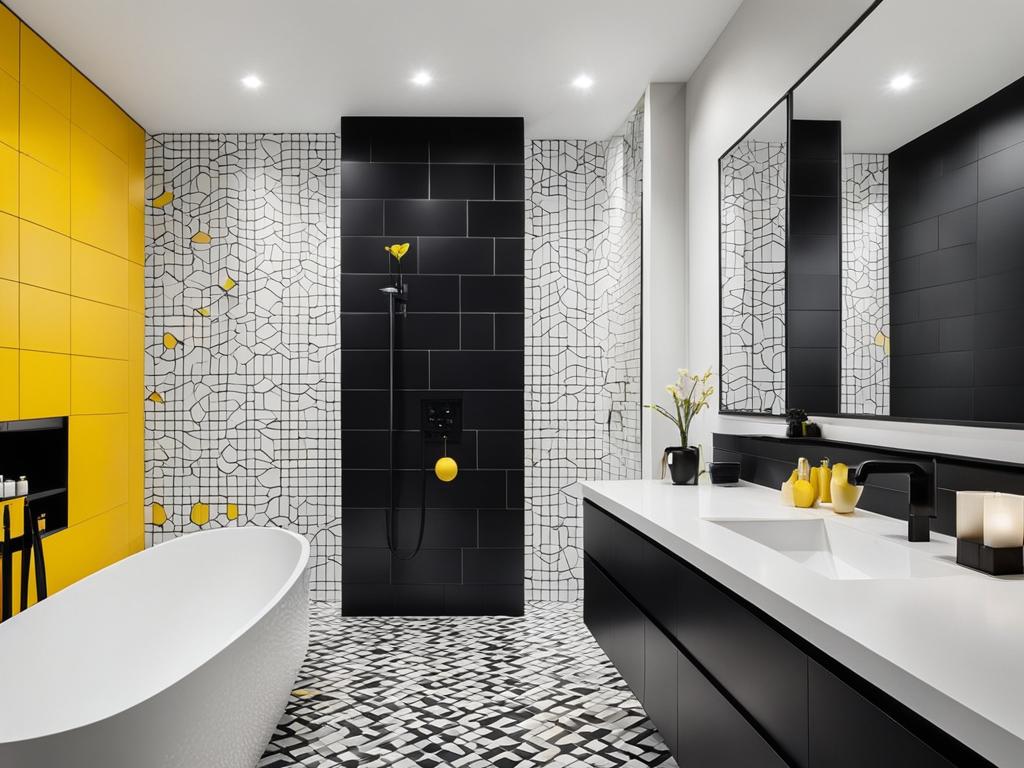
| Key Elements in a Postmodern Bathroom Design | Description |
|---|---|
| Marble-topped Vanity | A luxurious marble countertop on a sleek vanity adds sophistication and serves as a focal point in your bathroom. |
| Geometric Tile Patterns | Use bold and playful geometric tile patterns on the walls or floors to create visual interest and add to the postmodern aesthetic. |
| Unconventional Lighting | Invest in unique and artistic light fixtures that defy traditional norms, showcasing the avant-garde spirit of postmodern design. |
| Minimalistic Accessories | Keep the accessories minimalistic, focusing on sleek and simple designs that allow the key elements to shine through. |
By carefully selecting and combining these elements, you can transform your bathroom into a space that exudes postmodern style and becomes a true design inspiration. Remember, the key is to think outside the box and let your imagination run wild!
Postmodern Rugs in Home Decor
Postmodern rugs can be a focal point in home decor, adding vibrance and character to a space. Whether you want to introduce a touch of postmodern style to your living room, bedroom, or even your office, postmodern rugs offer a unique way to enhance the overall aesthetic of the room.
One of the defining features of postmodern rugs is their use of patchwork and geometric designs. These patterns create a visually striking and attention-grabbing element that instantly becomes a conversation piece in any room. The bold patchwork designs combine different textures, colors, and patterns to create a dynamic and eclectic look.
Additionally, geometric designs are a common feature in postmodern rugs. These designs often incorporate bold shapes and lines that add a sense of energy and movement to the space. Geometric patterns can range from simple and understated to complex and intricate, allowing you to choose a rug that best suits your personal style and the overall decor of your home.
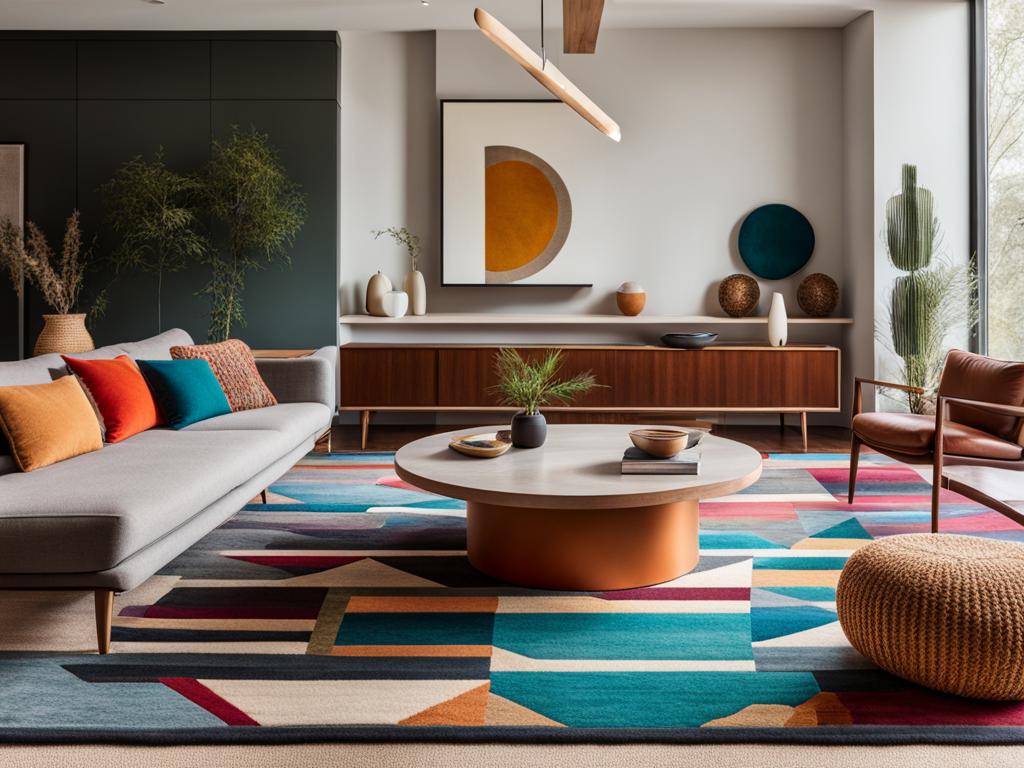
What sets postmodern rugs apart is their use of vibrant colors. Instead of sticking to traditional neutrals, postmodern rugs embrace bold and vibrant shades that make a statement. Whether you prefer vibrant reds, electric blues, or neon yellows, there is a postmodern rug that can add a pop of color and personality to your space.
Famous Postmodern Rug Designs
“The Celestial Rug” by Eduardo Paolozzi is a renowned postmodern rug design that features abstract shapes and celestial motifs, creating a whimsical and otherworldly aesthetic.
“The Puzzle Rug” by Ettore Sottsass is another iconic postmodern rug design. This rug showcases a puzzle-like pattern with vibrant colors, inviting people to observe and interact with the piece.
Advantages of Postmodern Rugs
- Instant focal point: Postmodern rugs instantly draw attention and become the focal point of any room they’re placed in.
- Expression of personal style: With a wide range of designs and colors available, postmodern rugs allow you to express your unique style and taste.
Whether you’re looking to add a vibrant accent to a minimalist space or create a bold and eclectic bohemian atmosphere, postmodern rugs offer a versatile and visually striking option for your home decor.
Postmodern Lighting Choices
When it comes to postmodern design, lighting choices play a crucial role in creating a visually striking ambiance. Postmodern lamps and fixtures offer bold and unique designs that can transform a room into a captivating space. From sculptural masterpieces to innovative lighting solutions, postmodern options bring a touch of avant-garde decor to your home.
The Statement of Sculptural Lamps
Postmodern lamps are not mere sources of light; they are artistic expressions. Sculptural lamps with bold designs become statement pieces, capturing attention and sparking conversation. These visually captivating fixtures combine intriguing shapes and unconventional materials to create a fusion of form and function. Illuminating your space with a postmodern lamp instantly adds an element of elegance and sophistication.
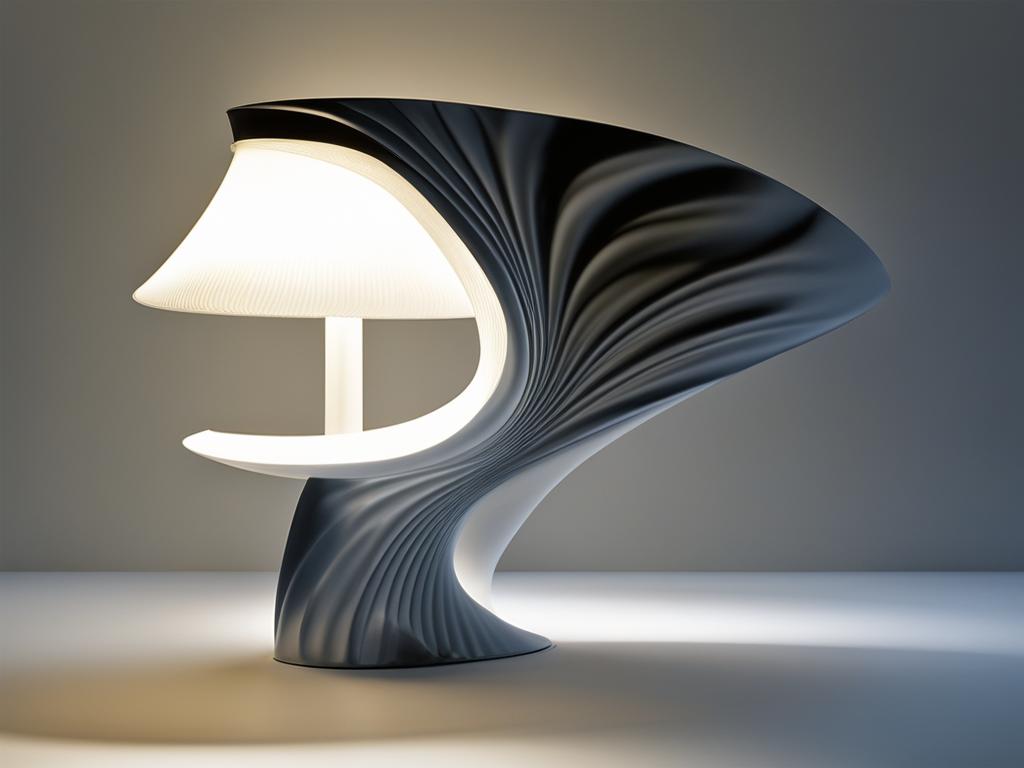
Innovative Lighting Fixtures
Postmodern lighting fixtures push boundaries and challenge traditional notions of lighting design. With postmodernism’s emphasis on uniqueness and creativity, these fixtures offer innovative solutions that defy expectations. Whether it’s a ceiling pendant with unexpected geometric shapes or a floor lamp that doubles as a sculpture, postmodern lighting options provide endless possibilities for adding a touch of artistic flair to your home.
Provoking Thought with Lighting Quotes
“Light creates ambiance and feel of a place, as well as the expression of a structure.” – Marjan van Aubel
As designer Marjan van Aubel eloquently describes, light has the power to shape the atmosphere and character of a space. In the realm of postmodern design, lighting becomes an integral part of the overall composition, evoking emotions and setting the tone for the environment. Thoughtfully placed and uniquely designed lighting fixtures can transform an ordinary room into a captivating work of art.
Unique Lighting Options
| Lighting Option | Description |
|---|---|
| Sculptural Lamps | Statement pieces with bold designs and unconventional materials. |
| Geometric Fixtures | Lighting solutions that feature unexpected shapes and angles. |
| Minimalist Pendants | Clean and sleek designs that emphasize simplicity and elegance. |
| Artistic Chandeliers | Chandeliers that double as works of art, adding grandeur and drama to a space. |
| Abstract Floor Lamps | Floor lamps that serve as sculptural elements and provide ambient lighting. |
Choose postmodern lighting options that resonate with your personal style and complement the overall theme of your space. By incorporating these bold designs and unique lighting options, you can elevate your home decor to new heights, creating a visually striking and avant-garde ambiance.
Postmodern Chairs for Contemporary Spaces
Postmodern chairs are a testament to minimalistic design and geometric shapes, making them the perfect addition to contemporary spaces. With their sleek lines and elegant forms, these chairs bring a touch of modern sophistication to any room. Crafted from a combination of organic and raw shapes, they create a delicate balance that adds visual interest and uniqueness to the overall aesthetic.
Postmodern furniture prioritizes simplicity and clean lines, resulting in chairs that radiate a minimalistic vibe. The absence of excessive details allows the geometric shapes to take center stage and become the focal point of the room. Whether it’s a chair with angular edges or a curved seat, these designs exude a sense of modernity and elegance.
The use of sleek and modern materials further enhances the contemporary appeal of postmodern chairs. From polished metal frames to smooth plastic surfaces, these chairs exude a sense of luxury and refinement. The combination of minimalist design and high-quality materials creates a harmonious balance that elevates the overall aesthetic of the space.
One notable feature of postmodern chairs is their versatility. They effortlessly blend into various interior styles, whether it’s a minimalist, Scandinavian, or industrial-themed room. The clean lines and geometric shapes of these chairs create a seamless integration within contemporary spaces, making them a favorite choice for homeowners and interior designers alike.
Examples of Postmodern Chairs:
| Chair Name | Designer | Description |
|---|---|---|
| Vitra Panton Chair | Verner Panton | A classic postmodern piece known for its sculptural and fluid design, the Panton Chair perfectly embodies the aesthetic of the era. |
| Kartell Ghost Chair | Philippe Starck | This transparent chair combines modern materials with a traditional Louis XVI silhouette, creating a juxtaposition of old and new. |
| Eames Lounge Chair | Charles and Ray Eames | An iconic piece that showcases the perfect harmony of minimalistic design and luxurious comfort. |
| Tulip Armchair | Eero Saarinen | A timeless chair featuring a single stem-like base and an organic-shaped seat, giving the illusion of floating in space. |
Postmodern chairs offer a contemporary twist on traditional seating options. With their minimalistic design and geometric shapes, these chairs create a sleek and sophisticated atmosphere in any home or office. Whether you’re looking to add a statement piece or want to create a cohesive modern aesthetic, postmodern chairs are a perfect choice for contemporary spaces.
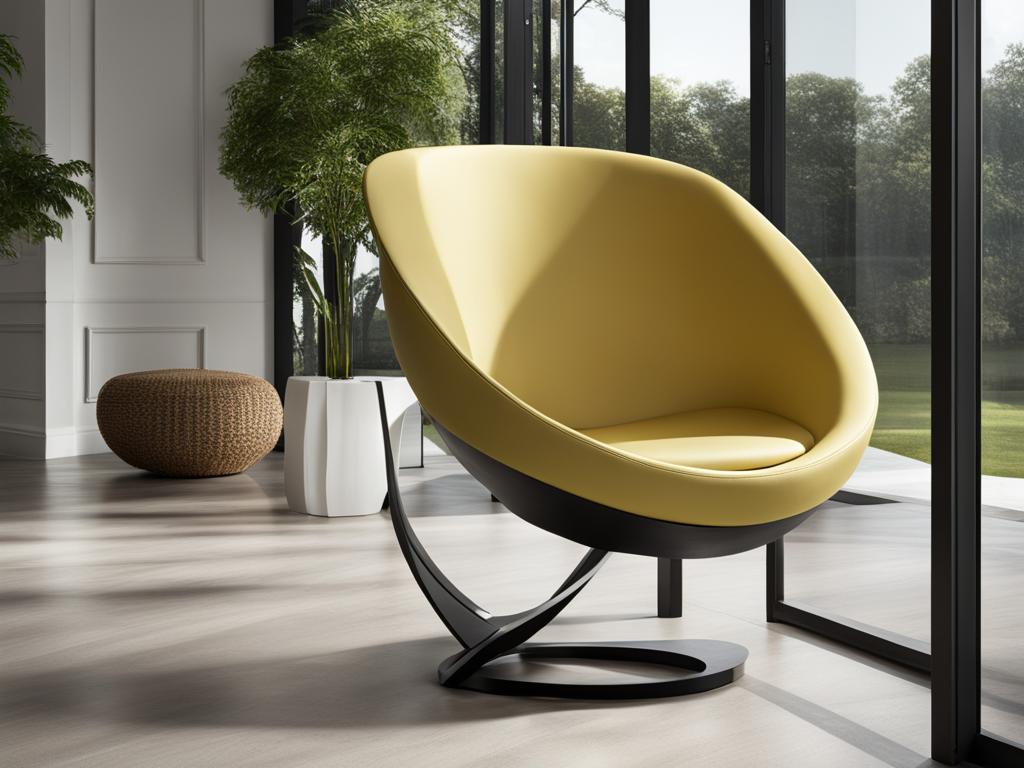
Creating a Postmodern-inspired Space
When it comes to interior design, creating a postmodern-inspired space provides the perfect opportunity for personal expression and exploration of unique decor choices. Postmodern design principles offer a creative leeway that encourages the freedom to experiment with color, form, and style, resulting in a visually striking and unconventional environment.
Postmodern furniture plays a crucial role in achieving the desired aesthetic. With its avant-garde designs and unconventional shapes, postmodern furniture adds a touch of uniqueness to any space. Whether it’s a sculptural chair that becomes the centerpiece of the room or a statement coffee table that sparks conversation, these furniture pieces embody the essence of postmodern style.
Unleashing Your Creative Leeway
When it comes to decorating in a postmodern-inspired style, there are no strict rules to follow. This offers you the creative leeway to explore and experiment, allowing your personal style to shine through. Incorporating unexpected elements and juxtaposing different textures and materials can add depth and interest to your space.
One approach is to mix and match different design eras and styles. Pairing a vintage postmodern chair with a contemporary sofa creates an eclectic and dynamic aesthetic. You can also experiment with bold color combinations or incorporate unexpected pops of vibrant hues to infuse energy into the space.
“Postmodern design is all about embracing the unexpected and celebrating the freedom to create a space that is truly unique and reflective of your personal style.” – [Name]
Embracing Unique Decor Choices
In a postmodern-inspired space, unique decor choices are highly valued. Opt for decorative objects and accessories that showcase artistic expression and unconventional design. Consider incorporating abstract sculptures, wall art with bold patterns, or avant-garde lighting fixtures that defy traditional norms.
Furthermore, don’t be afraid to mix materials and textures to create a visually engaging atmosphere. Combining sleek metal with plush velvet, or rough concrete with smooth glass, adds intrigue and depth to your postmodern-inspired space.
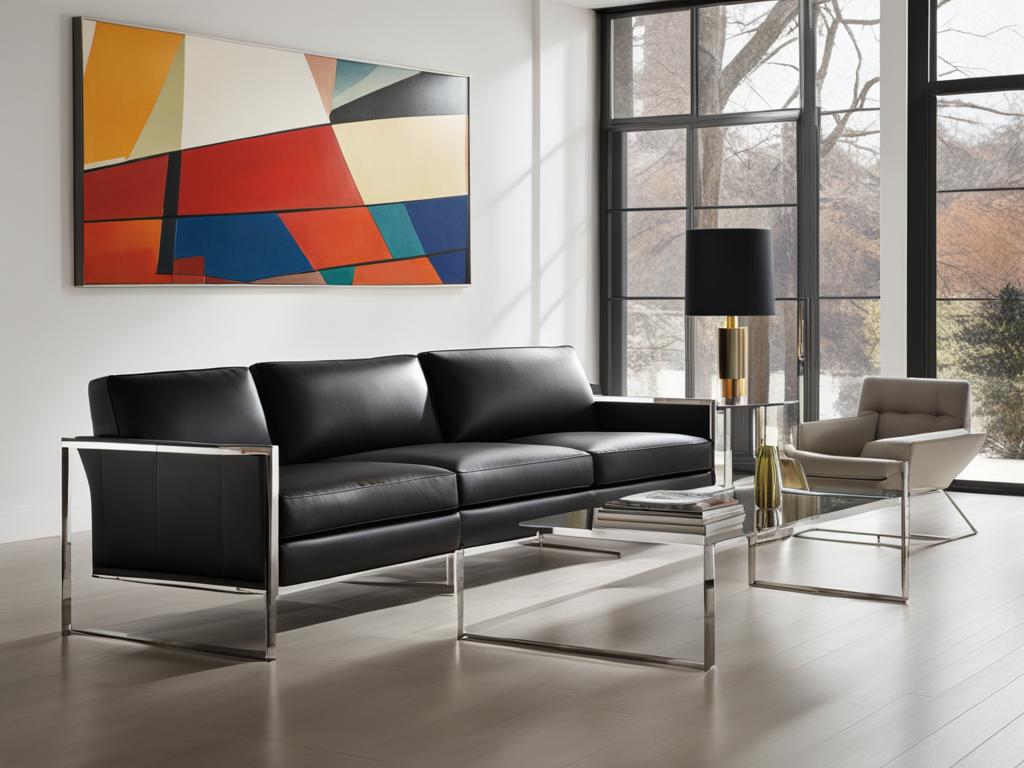
Finding Your Personal Style
Creating a postmodern-inspired space not only allows you to tap into your creative side but also enables you to develop a personal style that is truly one-of-a-kind. Consider the elements and design choices that resonate with you the most, and incorporate them into your space.
Whether you prefer a minimalist approach with clean lines and neutral colors, or you lean towards a more eclectic mix of patterns and textures, postmodern design provides the perfect canvas for self-expression.
Remember, the key to achieving a successful postmodern-inspired space is to embrace the unexpected, explore your creative leeway, and let your personal style shine through.
Where to Shop for Postmodern Furniture
Finding postmodern furniture that perfectly complements your unique style and design preferences is an exhilarating journey. Luckily, there are several avenues to explore when searching for authentic and captivating pieces of postmodern furniture. Whether you are a fan of vintage finds or prefer contemporary manufacturers, there are plenty of options available to you.
Shopping for Vintage Pieces
If you have a fondness for history and appreciate the charm of timeless pieces, vintage furniture is the way to go. Vintage stores and dealers offer an array of postmodern furniture, including iconic designs from renowned designers. You can discover hidden gems that carry the essence of the postmodern era and add a touch of nostalgia to your spaces. From sleek chairs to avant-garde lighting fixtures, vintage pieces can inject character and history into your home.
Exploring Contemporary Manufacturers
If you prefer a more modern take on the postmodern aesthetic, contemporary furniture manufacturers are at your service. With a focus on innovative designs, these manufacturers produce postmodern furniture that seamlessly integrates into contemporary spaces. By incorporating elements of postmodern design, such as playful forms, bold colors, and unconventional shapes, they create furniture pieces that exude creativity and uniqueness. Many contemporary manufacturers provide a wide range of options, ensuring that you can find postmodern furniture that suits your taste and complements your existing decor.
Online Marketplaces
The convenience of online shopping cannot be overstated, especially when searching for postmodern furniture. Online marketplaces like [Marketplace Name], [Marketplace Name], and [Marketplace Name] offer an extensive selection of postmodern furniture from around the world. With just a few clicks, you can explore countless listings, compare prices, and read reviews to make informed decisions. These online platforms provide a convenient way to shop for postmodern furniture, giving you access to a global marketplace and a diverse range of designs.
Whether you choose to explore vintage stores, browse through contemporary manufacturers’ collections, or leverage the convenience of online marketplaces, you are sure to find the perfect postmodern furniture to elevate your living spaces. Happy shopping!
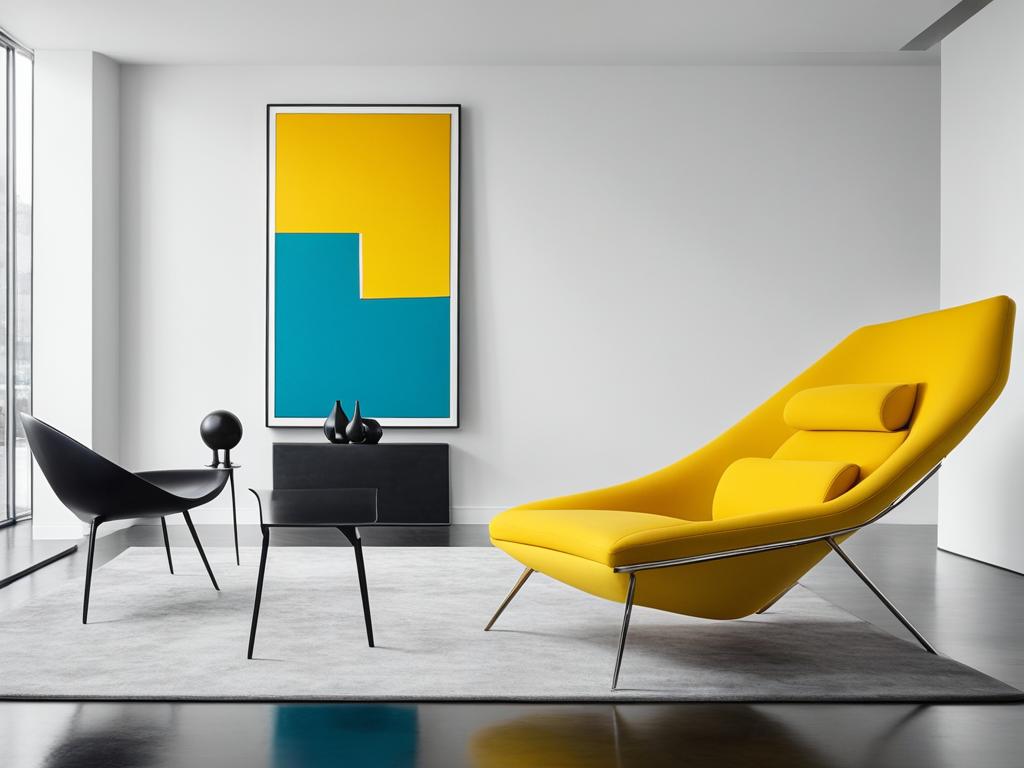
Embracing the Postmodern Aesthetic
When it comes to interior design, embracing the postmodern aesthetic offers a captivating blend of minimalist design, avant-garde decor, and bold expressions. This unique style allows you to create visually engaging spaces that challenge traditional norms and ignite a sense of creativity. By mixing various design styles and experimenting with unconventional elements, postmodern furniture becomes the centerpiece of a visually stunning and eclectic home.
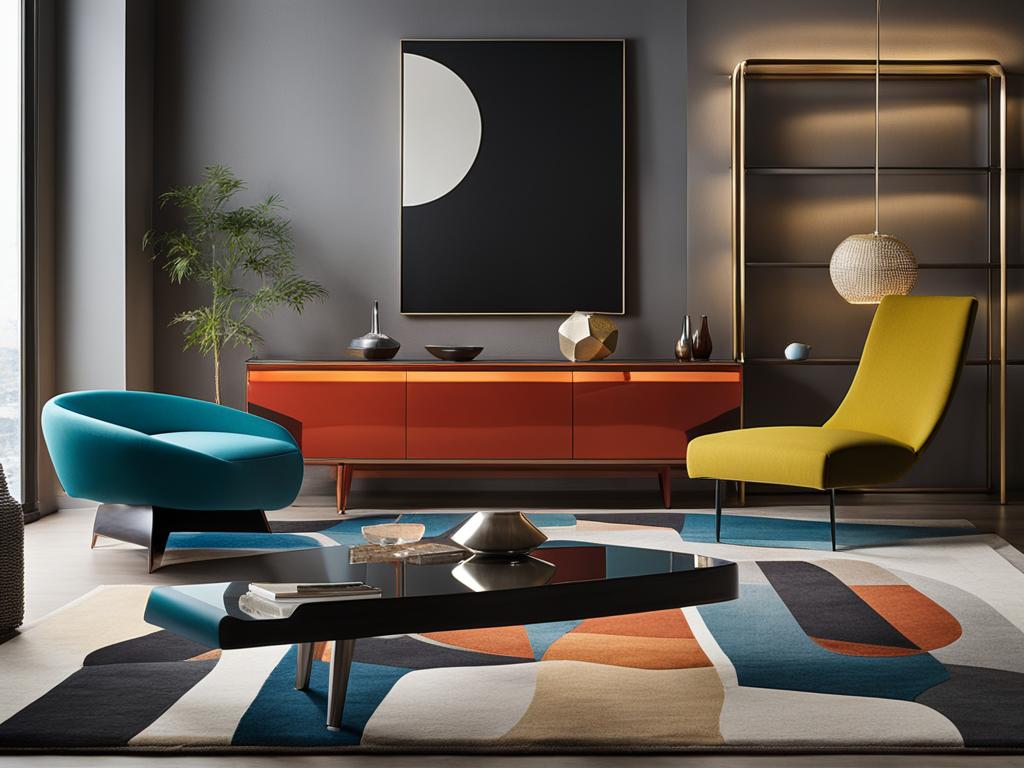
Postmodern design celebrates the beauty of simplicity and the unexpected, making minimalist design principles a perfect fit. Clean lines and uncluttered spaces provide the backdrop for bold expressions and avant-garde decor choices. Think sleek and streamlined pieces that exude elegance, paired with unconventional shapes and materials that challenge convention.
A key aspect of postmodern design is the freedom to mix styles and pull inspiration from various sources. By combining elements of classic modernism, industrial aesthetics, and even pop art, you can create a captivating juxtaposition of different eras and influences. Embracing this unique blend cultivates a space that reflects your individuality and sparks intriguing conversations.
“Postmodern design encourages the freedom to experiment with unconventional elements, creating a space that embodies your personality and showcases your boldness. It’s an invitation to break free from traditional constraints and embrace the beauty of artistic expression.”
To further enhance the postmodern aesthetic, consider incorporating avant-garde decor. This can include bold color choices, unexpected textures, and eye-catching design features. Embrace the use of vibrant hues, unconventional patterns, and statement-making accents to create a sense of visual drama and intrigue within your space.
Creating a Bold and Expressive Space
When it comes to postmodern furniture, the possibilities are endless. Combining minimalist design principles, avant-garde decor, and bold expressions, you can curate a space that evokes curiosity and stands out from the crowd. Here are some key tips to help you embrace the postmodern aesthetic:
- Incorporate sleek and streamlined furniture pieces with clean lines. Opt for minimalist designs that boast simplicity and elegance, allowing them to harmonize with the bold and avant-garde elements in your space.
- Experiment with unconventional shapes and materials. Consider furniture pieces with unique contours or unexpected combinations of materials such as metal, glass, and wood. These elements contribute to the overall postmodern aesthetic, creating a visually stunning ambiance.
- Choose a bold color palette to infuse vibrancy into your space. Complement neutral tones with pops of bright and vibrant hues, creating a visually striking contrast that captures attention.
- Integrate avant-garde decor through art installations, statement lighting fixtures, and daring accessories. These elements add an extra layer of intrigue and bolster the overall boldness of the postmodern design.
- Focus on creating an environment that challenges traditional design norms and evokes a sense of wonder. Don’t be afraid to push boundaries and embrace your unique style preferences.
Remember, embracing the postmodern aesthetic is about celebrating individuality, encouraging artistic expression, and creating spaces that go beyond the ordinary. By combining minimalist design, avant-garde decor, and bold expressions, you can unleash your creativity and design a home that truly represents you.
Conclusion about Postmodern Home Decorating
In the world of interior design, postmodern home decorating stands out as a unique and avant-garde approach. This style draws inspiration from various design movements, breaking free from traditional norms and embracing bold expressions, playful forms, and unconventional elements. Postmodern design allows for creative freedom, enabling the creation of visually stunning and truly unique spaces.
One of the defining features of postmodern home decorating is the use of vibrant colors, which inject energy and personality into the space. From bold primary colors to vibrant pastels, the color palette in postmodern design knows no bounds, offering endless possibilities for creative expression.
Minimalism is another prominent design trend within postmodern home decorating. While postmodern design can be exuberant and eclectic, it also celebrates simplicity and clean lines. A balance between extravagance and minimalism creates an intriguing juxtaposition, allowing each element in the space to stand out and make an impact.
Ultimately, postmodern home decorating enables individuals to create a space that is a true reflection of their personal style. By combining different design elements, exploring various materials, and embracing the beauty of complexity and contradiction, a unique and visually stunning postmodern-inspired space can be achieved.
FAQ
What is postmodern furniture?
Postmodern furniture is characterized by its eclectic mix of design styles and the incorporation of historical elements, craft revival, ergonomic furniture, and art furnishings. It embraces a diverse range of influences from classic modernism to Memphis style, Deconstructivism, and industrialized high-tech style.
What are some popular modern décor elements used in postmodern style?
Some popular modern décor elements used in postmodern style include pop art motifs, colorful free-formed glass vases, and whimsical themes. These elements enhance the exuberance of the decor and contribute to the overall vibrancy of the space.
What materials are commonly used in postmodern design?
Materials commonly used in postmodern design include plastic, laminates, concrete, marble, glass, metal, and wood. In the 1970s, postmodern style also embraced the trend of recycling and incorporated unexpected recycled materials into furniture and decor.
Who are some notable postmodern designers?
Some notable postmodern designers include Robert Venturi, Michael Graves, Philip Johnson, Alessandro Mendini, Robert A.M. Stern, and Judy McKie. These designers have made significant contributions to postmodern design through their unique and influential creations.
How can postmodern style be incorporated into the bedroom?
Postmodern style can be incorporated into the bedroom by combining various design elements and embracing a mix of styles. This allows for the creation of an eclectic and unique sanctuary that reflects personal style and provides a dynamic and intriguing environment for rest and relaxation.
How can postmodern style be applied in the kitchen?
Postmodern style can be applied in the kitchen by taking inspiration from the Memphis Group, a design collective known for bold shapes and bright colors. By embracing unique and playful design elements that break free from traditional norms, the postmodern kitchen becomes an unconventional and visually striking space.
How can postmodern style be integrated into the bathroom?
Postmodern style can be integrated into the bathroom by incorporating elements such as a miniature copper claw-foot tub, walnut medicine cabinet, and marble-topped vanity. These unique elements, inspired by postmodern designers, create a visually striking and functional space.
How can postmodern rugs enhance home decor?
Postmodern rugs can be a focal point in home decor, adding vibrance and character to a space. With patchwork and geometric designs featuring vibrant colors, postmodern rugs create a conversation piece and enhance the overall aesthetic of the room.
What are some unique lighting choices in postmodern style?
Postmodern lighting choices offer bold and unique designs that can become statement pieces in a room. From sculptural lamps to innovative fixtures, postmodern lighting options add a touch of avant-garde decor and create a visually striking ambiance.
How do postmodern chairs contribute to contemporary spaces?
Postmodern chairs showcase minimalistic design with geometric shapes, adding a contemporary touch to any space. The combination of organic and raw shapes with sleek and modern materials creates a delicate balance that adds visual interest and uniqueness to the room.
How can a postmodern-inspired space be created?
Creating a postmodern-inspired space allows for personal expression and offers creative leeway to explore unique decor choices. Postmodern design principles encourage the freedom to experiment with color, form, and style, resulting in a visually striking and unconventional environment.
Where can postmodern furniture be purchased?
Postmodern furniture can be found through various avenues, including shopping for vintage pieces or exploring contemporary manufacturers. Online marketplaces, vintage dealers, and specialty retailers offer a wide range of options to find authentic postmodern furniture that aligns with personal style preferences.
What does it mean to embrace the postmodern aesthetic?
Embracing the postmodern aesthetic involves incorporating minimalist design with avant-garde decor to create bold and visually engaging expressions. With the freedom to mix various styles and experiment with unconventional elements, postmodern design offers a unique and impactful way to create a visually stunning space.
What is the significance of postmodern home decorating?
Postmodern home decorating offers a unique and avant-garde approach to interior design. Drawing inspiration from various design movements, postmodern style breaks free from traditional norms and embraces bold expressions, playful forms, and unconventional elements. It allows for creative freedom and the creation of visually stunning and unique spaces.

